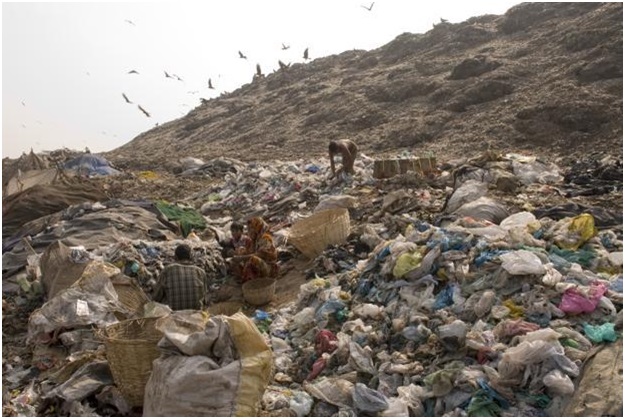India is likely to see its
waste generation triple to 376,639 tonnes per day by 2025. The solution to
managing this could lie in segregating the waste.

In a majority of the cities in the country, solid waste goes straight to
landfills without any segregation. Once the site is filled, the authorities are
expected to find another, not always easy give
n the pressure of land. Photo:
Hindustan Times
 New
Delhi:
Sheetal Pawar, a housewife who lives in the Katraj ward, or prabhag as it is
known locally, of Pune, began segregating the waste generated by her household
into dry (or inorganic) and wet (organic) waste two years ago. It was part of a
pilot initiated jointly by four organizations in Pune to move towards zero
waste developed on the philosophy of recycling garbage—a practice already in
vogue in metropolises like New York and London.
According to Pawar it was
not a difficult practice to weave into her daily routine; while the organic
waste including vegetable peel, egg shells and leftover food is deposited in a
green coloured bin, all the inorganic waste like paper, plastic and aluminium
are placed in a white bin.
The waste collected from
each home is no longer dumped in a landfill. Instead, they are diverted as raw
material for biogas, composting and waste-to-energy plants, resulting in
attendant savings besides reduction in the volume of household waste.
“We have been able to save
Rs.60,000-70,000 on transportation costs per
month as all the waste does not
got to the landfill. Also, we save Rs.6. 57 lakh on electricity costs for
street lights per biogas plant,” says Suresh Jagtap, joint municipal
commissioner, Pune Municipal Corporation (PMC).
Enthused by the initial
success, the city authorities have since February begun to scale up the
project. Jagtap claims the next phase will see the experiment extended to 20
more wards—covering little less than a fourth of the city of Pune with a
population of 3.115 million.
The
case for segregation
Analysts say segregation of
waste could be the first step towards managing solid waste in the country,
which is rapidly becoming a cause for concern. In a majority of the cities in
the country, solid waste goes straight to landfills without any segregation.
Once the site is filled, the authorities are expected to find another, not
always easy given the pressure of land.
A 2012 World Bank report
said that urban India generates 109,589 tonnes of waste per day; as compared to
urban United States which generates 624,700 tonnes per day, the highest in the
world and the second largest is urban China at 520,548 tonnes per day. India’s
waste generation
will more than triple to 376,639 tonnes per day by 2025,
especially with the population of urban India expected to rise to 538 million.
“As countries, particularly
India and China, continue their rapid pace of urbanization and development,
global solid waste quantities are projected to increase considerably,” the
report added.
Naim
Keruwala,
project consultant at Janwani, a not-for-profit, one of the organization
involved in the implementation of the Katraj initiative, said the pilot was
started as there was an outcry in the villages adjoining the landfills.
“There were protests by
local villagers who didn’t want a landfill which brings the waste from the city
to their area,” he said.
Pune is not the only city
where people living near a landfill site have protested, said Ravi
Agarwal,
founder and director of Toxics Link, a not-for-profit group that works on waste
issues.
“There have been attempts
by small groups in cities like Chennai, Bangalore and Delhi to segregate waste and
to convert biodegradable waste into compost and to recycle the
non-biodegradable,” he said.
Agarwal said none of them
have been able to scale this model beyond a few wards or localities as it is in
direct conflict with the privatization of waste, which is what t
he governments
are promoting.
“Municipalities want to
control plastic and waste and there is no support for these projects. They do
not fail because of design but because the government doesn’t support them.
Despite several attempts, these projects have failed as the municipal
corporation has to support it for it to work,” he said.
The
business case
The key to managing
municipal solid waste is segregation says Jagtap.
Keruwala said that zero
garbage doesn’t mean that garbage is not created; all it means is that it is
utilized in the same area. According to him, the key to its success is the fact
that it is beneficial for all the stakeholders including wastepickers, the
municipality and the hous
eholds.
“A wastepicker is roughly
able to earn Rs.4,000-5,000 a month as each household pays Rs.30 to a
wastepicker per month to collect segregated waste from their houses,” he said.
This includes the money they earn from selling the the inorganic waste like
plastic, paper and aluminium to recycling units, Keruwala adds.
According to Agarwal, the
pilot in Pune was a success because the municipal corporation backed the plan.
“All that this kind of a project requires is institutional support,” he adds.


